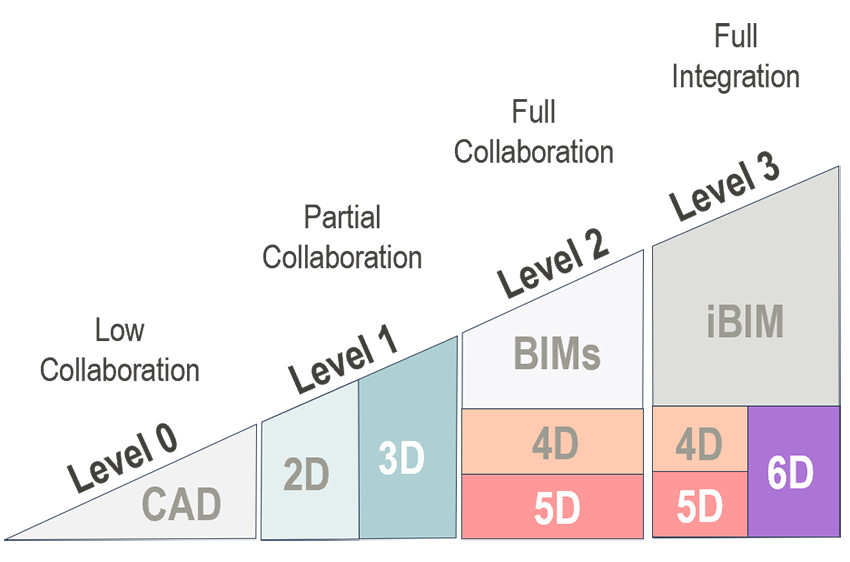
Asset Management Manual
A guide for practitioners!

Asset Management Manual
A guide for practitioners!
BIM was originally associated with planning, design and later with the construction. The focus was on the interests of the designer and the construction companies or, more generally, the service providers or contractors. This is beginning to change, and the latest developments within BIM are focusing on the owner and operator of the asset.
The construction industry has been suffering from very low productivity for several decades. It deviates sharply from the efficiency of the economy as a whole in almost all countries, and the gap is gradually widening. This can be clearly confirmed by statistical data, i.e. (NBS, 2019). Most experts explain this low productivity by the backlog in digitalization in the construction industry. The level of digitalization in the construction industry is indeed dramatically low worldwide. The term digitalization is used hereafter as a change of process to incorporate digital technologies unlike digitization which describes the pure analogue-to-digital conversion of existing data and documents.
The vast majority of professionals in the construction industry consider BIM as a synonym for modern planning and design techniques, supported by the CAD (Computer-Aided Design) software, which make it possible to create a virtual construction object that acts as a kind of digital twin of the designed real object. Thanks to the use of modern 3D techniques, it is possible not only to visualize the final result but also to simulate all the construction phases and assembly processes by adding a further, fourth dimension, time, optimizing the entire future environment of the construction site. The result of using these techniques is a high quality of both the project itself and, in the next phase, the completed construction object, compliance with the given schedule and high-cost discipline. Costs are considered as the fifth dimension in projects realized according to the BIM principles.
To support the above principle, procedures have been developed and tools implemented that supply the designer and manager of construction projects an arsenal of effective and efficient methods that optimize their work. This section in the Asset Management Manual does not aim to present these BIM principles already documented in numerous manuals and other publications. However, for those who have not yet dealt with BIM, the definitions of only a few, frequently used basic terms are briefly presented below.
When describing a BIM-oriented project, the dimensions of the respective model are often specified. From this, a wrong conclusion is sometimes drawn about the quality of the particular BIM solution. However, it is not recommended to strive for an ever-higher dimension of the BIM model, but rather to choose such a dimension that best meets the objectives of the given project.
The BIM dimensions have been listed below, based on (NBS, 2021):
2D BIM is a digital geometric model that constitutes an X and a Y axis associated with further information.
3D BIM is a digital geometric model that constitutes an X, Y and Z axis associated with further information. Furthermore, where specific information is added or linked to these models then further benefits can be seen.
4D BIM is adding scheduling information to model construction sequences. Adding a dimension of time allows the project team to better visualize how the construction will be sequenced. From a contractor point of view, this is vital. 4D BIM was a huge step forward for the industry when first made possible through the use of new modelling tools – it demonstrated collaboration between the design and construction team through coordination and sharing of 3D models.
5D BIM is generally considered to be adding cost information to a model.
6D BIM is considered by some to be adding facility management to the information set.
The BIM dimensions are associated with the maturity levels of BIM (Level 0 to Level 3), as illustrated in Figure 4.3.2.1.

Digital Twin
The term "digital twin" describes the "digital assets", i.e. the models or documents that represent a real, physical object throughout its lifecycle or at certain stages of its lifecycle. In the “BIM industry” (construction), a digital twin usually refers to a 3D geometric model of a building or bridge with all relevant attributes that represents and reacts to the real, physical twin, i.e., the real building or bridge, and may also generate certain reactions and changes in the real object. There can be a connection between the real twin and the digital twin. This connection can be either one-way or two-way (in both directions). Moreover, the connection can be either synchronous or asynchronous, depending on the so-called "coupling level".
CDE - Common Data Environment
The common data environment (CDE) is the central data repository required to perform the BIM Level 2 information sharing function. The CDE collects, manages and distributes relevant validated digital information about a built asset during the life cycle for multidisciplinary teams at the specified access level.
The CDE platform is generally hosted on an external server which is accessible to all parties involved in the in the design, construction and operation of the asset with the appropriate permissions. The CDE platforms have an automated information flow. Additionally, they use predefined ways of sharing, accepting and commenting digital information.
IFC - Industry Foundation Class
The Industry Foundation Class (IFC) is an open data format developed by buildingSMART for the information exchange and coordination between different process participants. The main advantage of such a format is its openness. Thus, it is possible to use it by software off different vendors (interoperability). IFC files contain all relevant object data such as geometry, location in space, individual elements data, element attributes.
buildingSMART
buildingSMART is an international organization aiming to promote the exchange of interoperable, open and non-proprietary data between software applications used within the construction industry. buildingSMART is involved in the development of IFC.
Level Of Detail
The level of detail (LOD) refers to the geometric content of the model and is used to define the required graphic content of the model at a particular stage of the project. As the project progresses, the components in the model will be delivered in more detail. For example, in the case of road design, one starts only with the gradient and the width of the road core to estimate the soil volumes. In the progress of the project, the cross slopes, geometry of the ditches and the layers of the road pavement are considered.
Level of Information
The level of information (LOI) determines the non-geometrical content of the model at certain stages of the asset. As the life of the asset progresses, the non-geometrical details increase. At the beginning, the pavement is represented as a purely geometric, spatial figure with individual pavement layers. As the project progresses, data on the individual layers is added, such as the construction material as well as detailed information on laboratory results. Later, in the operational phase, the bearing capacity of the overall structure and other condition data for the surface layer, such as skid resistance, are included.
Level of Model Definition
The level of model definition (LOMD) is the combination of LOD and LOI and defines the details required in a model at different stages of the project, both graphical and non-graphical. The client (owner, employer, customer) determines the level of detail required and documents it in the Exchange Information Requirements (EIR).